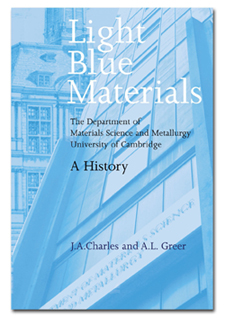 The history of the University of Cambridge's Department of Materials Science & Metallurgy has been documented in the book Light Blue Materials, from small beginnings to international significance. The story is told through accounts of the Department staff, the main areas of effort in the Department, and some individual characters with unique contributions to Department life. Organisation of the text is largely chronological by successive Heads of Department, interspersed with consideration of the specific areas of research and finally looking ahead to the future of the Department. The appendices contain detailed class lists, a research student list and Departmental photographs.
The history of the University of Cambridge's Department of Materials Science & Metallurgy has been documented in the book Light Blue Materials, from small beginnings to international significance. The story is told through accounts of the Department staff, the main areas of effort in the Department, and some individual characters with unique contributions to Department life. Organisation of the text is largely chronological by successive Heads of Department, interspersed with consideration of the specific areas of research and finally looking ahead to the future of the Department. The appendices contain detailed class lists, a research student list and Departmental photographs.
The royalties from every copy sold are to go to a student-assistance fund so as to reflect the collaborative nature of this publication.
Some topics included in the book are: The National Education Background in the Nineteenth Century; The work of Heycock and Neville; Studies in Corrosion and Electrochemistry; Field Ion Microscopy; Electron Microscopy; Functional and Device Materials; Wear; Joining of Materials; Archeometallurgy; Biomedical Materials; the contribution of Assistant Staff.
SPECIAL OFFER PRICE £27.00/$52.50 (cover price £36.00/$70.00) plus p&p (postage cost available on request)
Order from Rebecca Stamford: email rm574@cam.ac.uk, phone 01223 334349 or fax 01223 762088
(ISBN 1 904350 35 6)
About the authors:
Dr Charles joined the Department of Metallurgy, University of Cambridge in 1960, after 13 years in industry. He retired in 1990 after wide metallurgical experience and is now University Emeritus Reader in Process Metallurgy and visiting Professor at University College, London, but retains a presence in the Cambridge Department as a Distinguished Research Associate. After more than forty five years association he is well placed to review its achievements.
Professor Greer graduated in the Department in 1976, and achieved a personal chair in 2001. He became Head of the Department in 2006 and has close associations with Sidney Sussex College. His study of the early work by Heycock and Neville in the Sidney chemistry laboratory at the end of the nineteenth century provided the foundation on which this history has been written.
